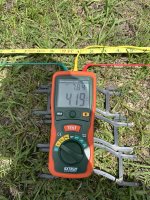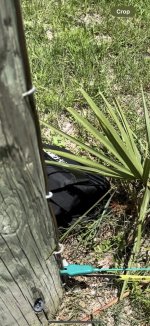I have some time on my minds so I picked up a Extech 382252 Earth Ground Resistance Tester Kit to do the Fall of Potential test on my POCO pole's ground and my home's ground system.
I did the 62% method with the farthest probe at 68 ft, which puts the center probe at 42 ft. All in a straight line. I zeroed the meter beforehand and also measured 0 earth voltage when the probes were placed.
For obvious reasons the earth ground at the POCO pole was still hooked up, which I know it is recommended to lift the ground during measuring.
The probes were 185 ft away from the next power pole that the pole I was measuring was hooked up to, so not sure how much it affects the reading to have the ground hooked up using this method.
I did lift the earth ground on my home when measuring, and made sure to flip the main disconnect off beforehand.
I didn't test each ground rod or the UFER ground individually since I didn't want to dig up pavers and disconnect them.
I suspect the 90 deg reading is higher than the 45 deg one due to being a bit closer to the UFER foundation or just soil conditions.
But overall it looks like the ground resistances all check out and are well below the NEC's <25 Ω requirement.
POCO Pole Earth Ground
59% = 3.89 Ω
62% = 4.19 Ω
65% = 4.66 Ω
Home's Earth Ground (2x 20ft ground rods + foundation UFER)
Location 1: (45 deg to foundation)
59% = 5.69 Ω
62% = 5.98 Ω
65% = 7.11 Ω
Location 2: (90 deg to foundation)
59% = 7.73 Ω
62% = 8.34 Ω
65% = 9.14 Ω
SPD Type Explanation
In the beginning of this thread it was recommended to get a Type 1 SPD as only having a Type 2 wouldn't provide as much lightning surge protection on the main service panel.
This is a misconception. I did talk with Siemens and they informed me that the UL certification only tests for 8/20 µs waveform. They don't test for 10/350 µs waveform like the IEC certification. This is the same for other SPD companies as well in the US who only certify for UL.
The ONLY difference between Type 1 and Type 2 in the UL certification is were it is allowed to be installed and if it requires an overcurrent protective device, not what type of waveform it protects against.
A type 1 or a Type 2 will perform the same if installed in a meter load center combo panel.
UL
Type 1 — One port, permanently connected SPDs, except for watt-hour meter socket enclosures, intended for installation between the secondary of the service transformer and the line side of the service equipment overcurrent device, as well as
the load side, including watt-hour meter socket enclosures and Molded Case SPDs intended to be installed without an external overcurrent protective device.
Type 2 — Permanently connected SPDs intended for installation on the load side of the service equipment overcurrent device; including SPDs located at the branch panel and Molded Case SPDs.
Type 3 — Point of utilization SPDs, installed at a minimum conductor length of 10 meters (30 feet) from the electrical service panel to the point of utilization, for example cord connected, direct plug-in, receptacle type and SPDs installed at the utilization equipment being protected. See marking in 80.3. The distance (10 meters) is exclusive of conductors provided with or used to attach SPDs.


